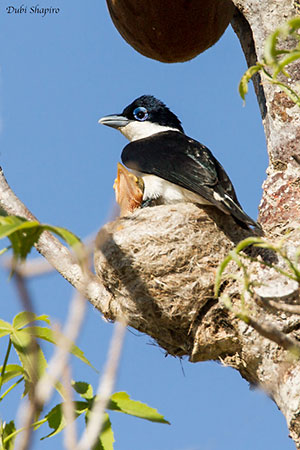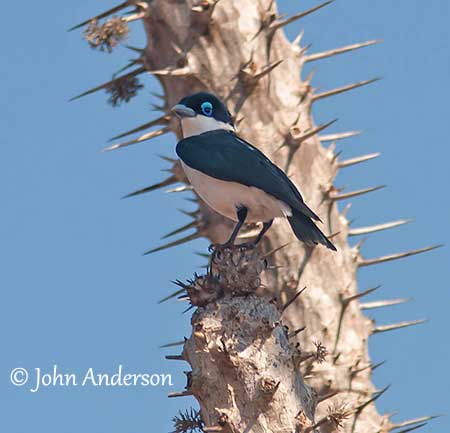
Fr : Artamie chabert
Ang : Chabert’s Vanga
All : Elstervanga
Esp : Vanga Chabert
Ita : Vanga di Chabert
Nd : Brilvanga
Sd : glasögonvanga
Mal: Fotsy tretreka, Pasasatra, Razangoaka, Sarigaga, Soroanja, torotoroka, Tsaramaso, Tsa-Tsak
Photographers:
John Anderson
John Anderson Photo Galleries
William Price
PBase-tereksandpiper & Flickr William Price
Dubi Shapiro
Dubi Shapiro Photo Galleries & Dubi Shapiro's Pictures on IBC
Alan & Ann Tate
AA Bird Photography
Text by Nicole Bouglouan
Sources :
HANDBOOK OF THE BIRDS OF THE WORLD Vol 14 by Josep del Hoyo-Andrew Elliot-David Christie - Lynx Edicions – ISBN: 9788496553507
Birds of Madagascar and the Indian Ocean Islands Par Roger Safford, Adrian Skerrett, Frank Hawkins – ISBN: 1472924118, 9781472924117- Editeur: Bloomsbury Publishing, 2015
The Birds of Africa: Volume VIII: The Malagasy Region: Madagascar, Seychelles, Comoros, Mascarenes - Par Roger Safford, Frank Hawkins – ISBN: 1408190494, 9781408190494- Editeur: A&C Black, 2013
Birds of Madagascar: A Photographic Guide Par Pete Morris, Frank Hawkins – ISBN: 0300077556, 9780300077551- Editeur: Yale University Press, 1998
Birds of the Indian Ocean Islands Par Ian Sinclair, Olivier Langrand - ISBN: 1868729567, 9781868729562- Editeur: Struik, 2003
A Photographic Guide to Birds of the Indian Ocean Islands: Madagascar ... Par Ian Sinclair, Olivier Langrand, Fanja Andriamialisoa - ISBN-10: 177007175X - ISBN-13: 978-1770071759 - Publisher: Struik Publishers (July 18, 2011)
Cooperative breeding in the endemic Madagascan Chabert’s Vanga Leptopterus chabert
Creagus – Bird Families of the World – Vangas - Vanginae
THE VANGAS OF MADAGASCAR by Nick Garbutt
Chabert’s Vanga
Leptopterus chabert
Passeriformes Order – Vangidae Family
INTRODUCTION:
The Chabert’s Vanga is endemic to Madagascar where it occurs in all native forest types from sea-level to 1,000 metres of elevation or higher. It forages actively in canopy and feeds mainly on various invertebrates.
This species has co-operative breeding system, with the breeding pair and one or more helpers that take part in nesting duties.
Two subspecies share the range on the island, and both are sedentary.
The Chabert’s Vanga is described as common throughout Madagascar, and it is not globally threatened.

DESCRIPTION OF THE BIRD:
Biometrics:
Length: 14 cm
Weight: 17,5-26-5 g
The Chabert’s Vanga of nominate race has black head and upperparts, including wings and tail. The black plumage shows glossy blue sheen.
The underparts are white, including chin, throat and neck sides.
On the head, forehead, crown, lores, ear-coverts and nape are like the upperparts.
The bill is pale blue. The eyes are dark red, surrounded by bare, fleshy eyering, turquoise-blue above and cobalt-blue below. Legs and feet are blackish.
Male and female are similar.
The juvenile resembles adult but the bright eyering is absent. The head looks paler with white fine streaks and feather tips contrasting with the black background. It has a dark line through the eye. Back and wing feathers are edged white.
SUBSPECIES AND RANGE:
The Chabert’s Vanga has two subspecies.
L.c. chabert (described above) is found in W, N and E Madagascar.
L.c. schistocercus occurs in SW Madagascar. It resembles nominate race but the outer rectrices are white on 2/3 of length, and have black tips.
HABITAT:
The Chabert’s Vanga frequents all forest types of Madagascar, including secondary growth, exotic plantations and scrubby vegetation. It can be seen far from native forest and in wooded areas around villages.
This species is visible from sea-level up to 1,000 metres of elevation and occasionally higher.
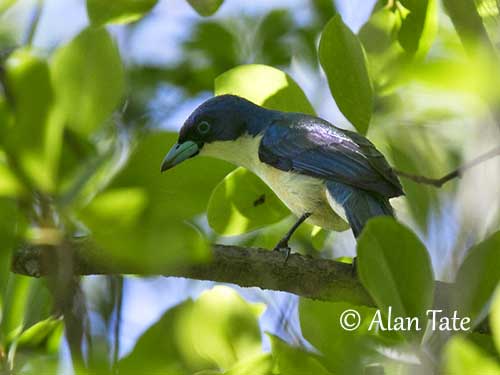
CALLS AND SONGS: SOUNDS BY XENO-CANTO
The Chabert’s Vanga in flight gives “tse tse tse tse” calls with some variations. This is a characteristic, mechanical note repeated 2-3 times per second. We can also hear “teedee” notes given in series. These calls are often uttered by several birds of a group flying overhead.
It also produces a soft drumming sound by clicking the mandibles when alarmed or excited.
BEHAVIOUR IN THE WILD:
The Chabert’s Vanga feeds on small to medium-sized insects such as Coleopterans, Blattodea and Orthopterans. It also takes worms, chameleons and small berries.
It forages actively in the canopy and hangs upside-down from twigs. It also hawks insects in flight. It sallies from perch to catch a prey and may hover to pick insects from the vegetation. It pursues flying insects in the air and catches them like a flycatcher.
It often occurs in small groups, and sometimes in flocks of about 30 individuals, and also in mixed-species flocks.
The Chabert’s Vanga has co-operative breeding system, and the helpers assist with nest building and attending the nest. The pair is monogamous and both mates usually share both incubation and chick rearing, with assistance of helpers.
The Chabert’s Vanga is sedentary. It flies long distances between its foraging sites, with characteristic bounding flight. It hovers and pursues insects in flight and makes low swoops in the air to catch them. When they are flying in groups, they have a “follow my leader” flight movement.
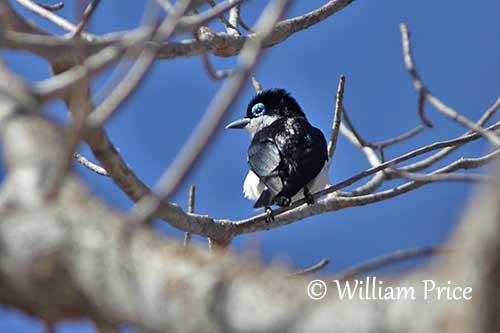
REPRODUCTION OF THIS SPECIES:
The Chabert’s Vanga breeds between August and October. It nests in tree forks and more often on horizontal branches, between 6 and 19 metres above the ground. The bowl-shaped nest is made with woven plant fibres and lichens, secured with spider webs. The nest is often firmly anchored to a horizontal branch. Male and female take part in nest-building with helpers that deliver nest materials.
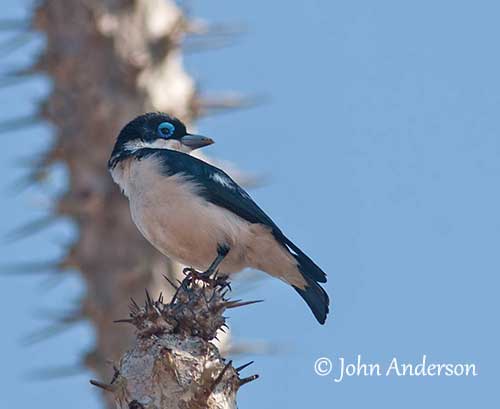
The female lays 3-4 dull, bluish-green eggs with small olive-brown spots. The length of the incubation is unknown, but both mates incubate in turn. From some observations on several nests, two chicks are fed by 2-3 adults and the predators are mobbed by the same adults with alarm calls and bill snapping.
The nestling period lasts 16 days. The young are fed near the nest by parents and helpers. They are still fed on various insect species for at least one week (but probably more) after fledging.
The Chabert’s Vanga is systematically a co-operative breeding species.
PROTECTION / THREATS / STATUS:
The Chabert’s Vanga is widespread, common or fairly common throughout Madagascar. The nominate race is common in all forest types. The race schistocercus is restricted to subdesert in SW and is fairly common.
The size of the population is unknown, but the Chabert’s Vanga is not globally threatened and currently evaluated as Least Concern.
